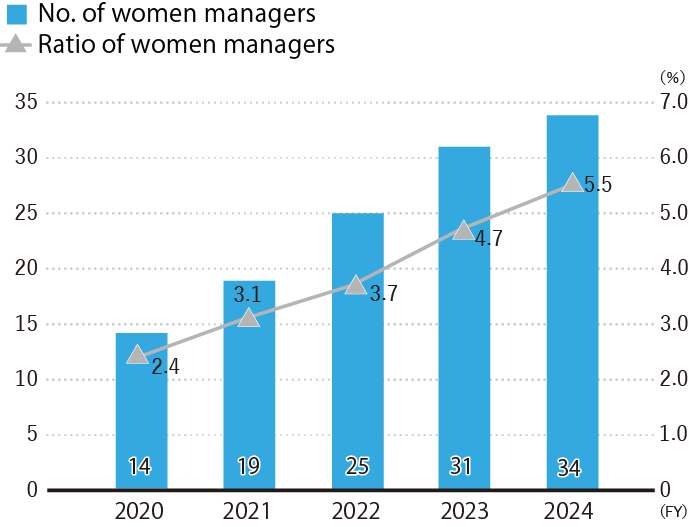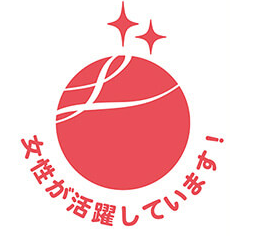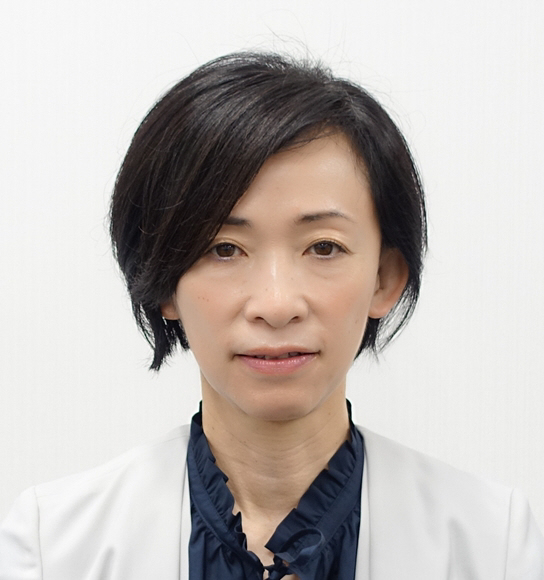Promotion of Women's Participation and Advancement
Progress so far, and the key issues
Promoting women's participation and advancement from the three perspectives of recruitment, cultivation, and support for employment continuation
As of 2015, the company was predominantly men-oriented, thus not providing adequate opportunities for women to thrive and grow. However, the group’s activities to promote women’s participation and advancement in the workplace started in earnest with the launch of the Women Empowerment Promotion Group in 2015.
In our Phase One Action Plan that spanned FY2017 to FY2021, we set targets of doubling the number of women managerial staff from the FY2016 level and raising the ratio of women career staff*1 to 15%. We have advanced a number of initiatives focused on the three aspects of recruitment, development, and support for continued employment. As a result, by the end of FY2021, we had tripled the number of women managerial staff to 13 and raised the ratio of women in career track positions to 17.1%, achieving our targets.
For our Phase Two Action Plan from April 1, 2021 to March 31, 2026, we announced a plan to raise the proportion of women in managerial positions to at least 5% and the proportion of women career staff to at least 22%. Additionally we set targets to achieve at least 80% of eligible men employees taking paternity leave and to increase the number of days of leave taken by 20% compared to FY2021 levels. We have already exceeded the targets for women representation in managerial positions and men’s parental leave uptake ahead of schedule.
A significant factor contributing to the achievement of these goals was our implementation of a recruitment policy setting a target of 40% women among recent graduate hires on the global career track*2. In parallel with this, we expanded the range of roles available to women and substantially increased their representation in traditionally men-dominated divisions such as sales and manufacturing. These actions have made the advancement of women more relevant for many managers, leading to shifts in attitudes and a transformation of the organizational culture overall.
In addition to continuing these measures, our ongoing challenge is to establish equal opportunities and responsibilities without gender discrimination as the standard practice, eliminating the need for affirmative action. We believe that achieving our Phase Two Action Plan is crucial for this transition, emphasizing the importance of increasing employee awareness and sensitivity toward diversity issues.
- *1
- Defined as all employees on the managerial career track, including those who have only recently joined the company.
- *2
- Includes all women employees holding the rank of section chief or higher.
Ratio of women Managers

Main measures implemented
- Women leader development seminars
- Diversity & inclusion training seminars for managers
- Career development support program
- Mentoring system (for women within the first two years after new graduate hiring or mid-career hiring)
- Promoting notification to superiors and employees planning to take leave, and conducting pre- and post-leave interviews to encourage more employees to take leave
- Babysitter support system, including partial coverage of childcare costs during business trips
- Establishment of an on-site nursery at the Research Center, with a capacity for 10 children
- Introducing maternity workwear for women employees in manufacturing
Targets and action plans
In April 2021, we started our Phase Two Action Plan for promoting participation and advancement by women. We set numerical targets to be achieved by FY2026 including at least 5% ratio of women managerial staff*3. To meet these targets, we are advancing an initiative to increase the ratio of women among recent graduate hires on the global career track to 40%. In FY2024, our ratio of women managerial staff was 5.5% and the ratio of women among recent graduates hires on the global career track was 35%.
In addition, we introduced a new Career Development Support Program for women employees who are currently on the regional career track*4. Participants meet with their supervisor over a period of three years to discuss a career development cultivation plan that incorporates a formal schedule for the acquisition of specialist technical know-how and other knowledge, for example through on-the-job training, as well as self-development, etc., with an implementation cycle that includes an annual progress report and refresher training.
We will present career development paths for women on the area career track, which had been unclear in the past, and will support the subsequent demonstration of capabilities by women employees.
Toyobo also has a policy of participating actively in external initiatives. The company has already expressed its support for 30% by 2030 Challenge*5 goal announced by the Japan Business Federation (Keidanren) to raise the ratio of women executives to 30% by 2030, and for the Women's Empowerment Principles*6, which outline a code of conduct for actively promoting women empowerment; Toyobo has signed a statement committing itself to act in accordance with the WEPs.
Through these activities, we received the second level Eruboshi*7 certification from the Minister of Health, Labour and Welfare in December 2021.

Targets and Initiative Content
| 【Target No.1】Raise the share of managers who are women to at least 5% by the end of fiscal 2026 | |
|---|---|
| April 2021 onwards: |
Implement women leader cultivation training for managers and women candidates for managerial positions (continued implementation since August 2017) |
| April 2021 onwards: |
Implement women leader cultivation training for section chiefs and women candidates for section chief positions (continued implementation since September 2019) |
| April 2021 onwards: | Implement mid-career hiring of women managers |
| May 2022 onwards: | Launch diversity & inclusion training seminars for managers Aim to enhance communication with diverse employees |
| 【Target No.2】Raise the share of women on the career track to at least 22% by the end of fiscal 2026 | |
|---|---|
| April 2021 onwards: | Maintain women's share of new graduate recruitment at a level of at least 40% |
| April 2021 onwards: | Actively promote mid-career hiring of women employees |
| April 2021 onwards: | Implement follow-up interviews for women employees (continued implementation since April 2015) |
| April 2021 onwards: | Establishment and operation of a three-year career development support program |
| 【Target No.3】Raise the percentage of eligible men employees taking childcare leave to at least 80%, and increase the number of days of childcare leave taken by at least 20% by the end of fiscal 2026 | |
|---|---|
| April 2021 onwards: | Make eligible employees aware of the childcare leave system (continued implementation since April 2019) |
| April 2021 onwards: | Send eligible employees' supervisors details of the encouragement that should be provided to subordinates to encourage them to take childcare leave (continued implementation since September 2019) |
| October 2022 onwards: | To support trouble-free acquisition of leave and return to work, interviews between superiors and leave-takers before and after taking childcare leave are mandatory |
- *3
- Career track for employees who are expected to be active throughout the entire company.
- *4
- Career track for employees whose career is expected to be confined to one specific business site.
- *5
- This is one of the targets for promoting D&I to realize sustainable growth in line with “. The NEW Growth Strategy” announced by the Keidanren in November, 2020.
- *6
- The Women's Empowerment Principles were formulated jointly by UNGC and UN Women in 2010.
- *7
- Eruboshi (2-star) criteria: Must meet 3–4 of the specified criteria, and must demonstrate continued improvement for a period of at least two consecutive years.
Message from manager
Our group's activities to promote women's participation and advancement in the workplace started in earnest with the launch of the Women Empowerment Promotion Group in 2015.
In April 2023, the department name was changed to Diversity & Inclusion Group. In addition to the existing women empowerment promotion, we have broadened the scope to include human rights issues and employment of people with disabilities, and we are addressing the foreign employees and LGBTQ+.
Achieving innovation and growing the company sustainably require that we remain a company that is able to acquire and utilize the skills and knowledge of diverse human resources. For participation and advancement by women, it is important that every woman is aware of her own capabilities and works where she can demonstrate those capabilities. For superiors, the maturity to provide opportunities and responsibilities fairly and without gender discrimination is vital.
The purpose of achieving diversity is adding value to people and making them strengths of the company.
Although we will continue affirmative action toward women due to its importance, we will go beyond that to also emphasize the importance of superiors realizing that attitudes and values have changed significantly among young people, and taking a stance of addressing people as individuals and providing opportunities fairly. We believe that workplaces where opportunities and responsibilities are provided regardless of personal attributes and where employees are able to grow will result in companies that are able to attract employees who have abundant knowledge and play active roles. Based on this conviction, we will retain affirmative action for women in the future and provide support for women, while taking steps to build workplaces where women can participate and advance without gender consciousness.

Diversity & Inclusion Group Manager,
Labor Affairs Department
Masako Tezuka






